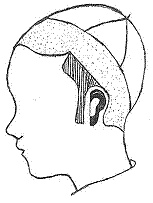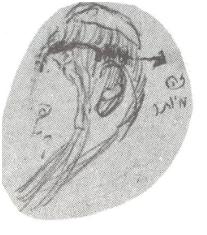Kashrus Kurrents Spring 2012
Q: When my barber works on the area around my ear and temple, what I am allowed to let him do and what should I stop him from doing?
A: The hair on a person’s head generally grows in a semicircle, starting from the top of the ear down to the nape of the neck and up again to the top of the other ear, as well as in an arc from one temple to the other. If a person joins that arc to the semicircle by shaving all the hair below the imaginary line from his temple to the back of his ear, he will be left with a circular shaped head of hair. The Torah1 forbids a man2 to ‘round’ the hair on his head. The meforshim explain this to mean that it is forbidden to create a circular head of hair by shaving below the line connecting the temple to the back of the ear, as described above.3 The hair that one is forbidden to shave is called the “pe’os ha’rosh”, and is shown as the striped area in the picture below:4

As some people may have lower or higher hairlines, making it difficult to accurately measure the height of the line connecting the temple to the back of the ear, it is prudent to err on the side of caution. Therefore, the sefer Yad Ketana encourages a person with a lower hairline not to shave in the area which would be forbidden to one with a higher hairline.5 The Chazon Ish is quoted as having said that the area extends from the temple to the hair just above the highest point of the ear, but does not include the hair starting behind the highest point of the ear continuing toward the back of the head.6 The Steipler Gaon demonstrated the area in question by drawing the following picture:7

[The text in the picture, זהו מיותר , refers to the area behind the ear which is not included in the prohibition].
It is forbidden to shave with a razor in the prescribed area. It is also forbidden to cut the hair with scissors, if it will cut the hair very close to the skin like a razor.8 If a person uses scissors, he should leave each blade of hair long enough so that he can grasp it with his fingers.9 Therefore, Rav Heinemann, shlit”a, paskens that each blade of hair should be left at least approximately 3 millimeters long.10 The Semag is of the opinion that it is forbidden to cut even two hairs of the pe’as ha’rosh in a forbidden manner.11 It is also forbidden for a Jew to allow a non-Jew to cut his hair in a forbidden manner.12
Included in this issur is the restriction for a man not to shave his sideburns. This applies to the hair in front of the ears, extending down to the cheekbone,13 which is approximately adjacent to the middle of the ear.14 These measurements denote the minimum shiur for pe’os ha’rosh. However, there is an old and widespread minhag in klal Yisroel to grow longer pe’os. Many people follow this custom and, in general, a person should continue to uphold the traditions of his family and community.
2. שו”ע יו”ד סי’ קפא סעי’ ו
3. עי’ ב”ח שם בשם הקרבן אהרן
4. מספר לשכנו תדרשו ח”א עמ’ ש (ושניתי הציור קצת)
5. יד קטנה ח”ב מצוה נג פ”ו מהל’ עכו”ם ס”ק עא, הובא בדרכ”ת סי’ קפא ס”ק יג
6. עי’ בספר לשכנו תדרשו ח”א עמ’ ש-שא
7. ספר ארחות רבינו ח”א עמ’ רלה (בדפוס ראשון)
8. עי’ בשו”ע שם סעי’ ב שיש לחוש לדבר האוסרים, והספר החינוך מצוה רנ”ב כתב שאף המתירים לא התירו אלא מדאורייתא אבל מדרבנן אסור, ועי’ בדרכ”ת שם ס”ק ב מש”כ בזה
9. שמעתי ממו”ר ר’ היינעמאן שליט”א, ועי’ בביה”ל ס’ רנא סעי’ ב ד”ה אפילו שכתב שיש לשייר “עכ”פ קצת מן הקצת”, אמנם נראה שלכתחלה יש לשאר עכ”פ כדי אחיזה, עי’ ברמב”ם פ”ה מהל’ נזירות הל’ אי ובלח”מ שם, ועי’ דרכ”ת שם ס”ק טז (וט”ס הוא שם וצ”ל טו) בשם החת”ס
10. שמעתי ממו”ר ר’ היינעמאן שליט”א
11. יסמ”ג לאוין נז הובא בטור סי’ קפא, ועי’ בב”י וב”ח ודרכי משה שם
12. שו”ע שם סעי’ ד
13. עי’ בב”י שם בבדק הבית בשם הריטב”א, ועי’ בשו”ע שם סעי’ א ובש”ך שם ס”ק א
14. ויש מחמירין שיש להניח פיאות יותר ארוכות קצת, עי’ בשו”ת אמרי יושר ח”ב סי’ קפג תשובת הגר”מ אריק זצ”ל לבעל שו”ת ארץ צבי, ועי’ ג”כ בשו”ת ארץ צבי סי’ ג מש”כ בזה, ועי’ בבית לחם יהודה על השו”ע שם מנהג האריז”ל בזה

 STAR-D
STAR-D STAR-S
STAR-S